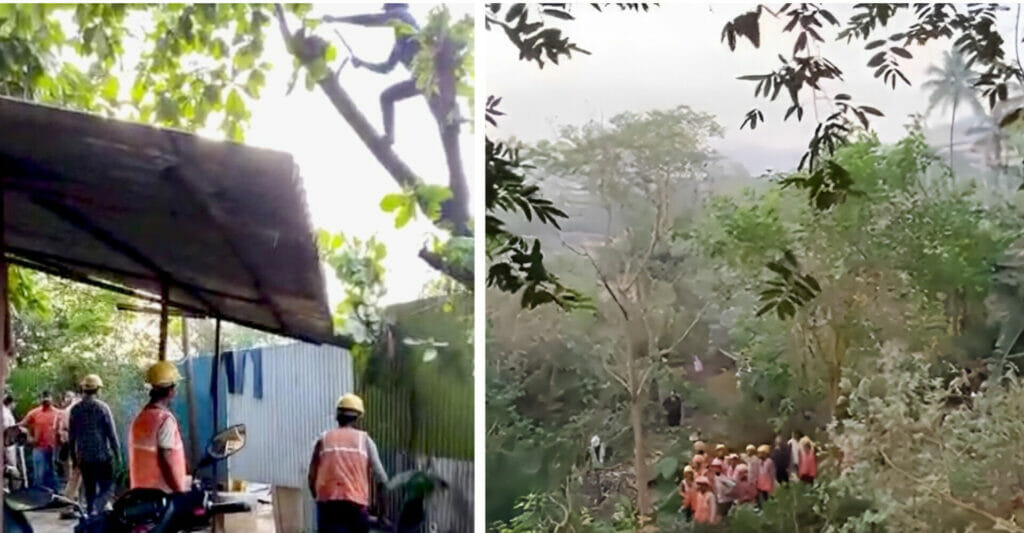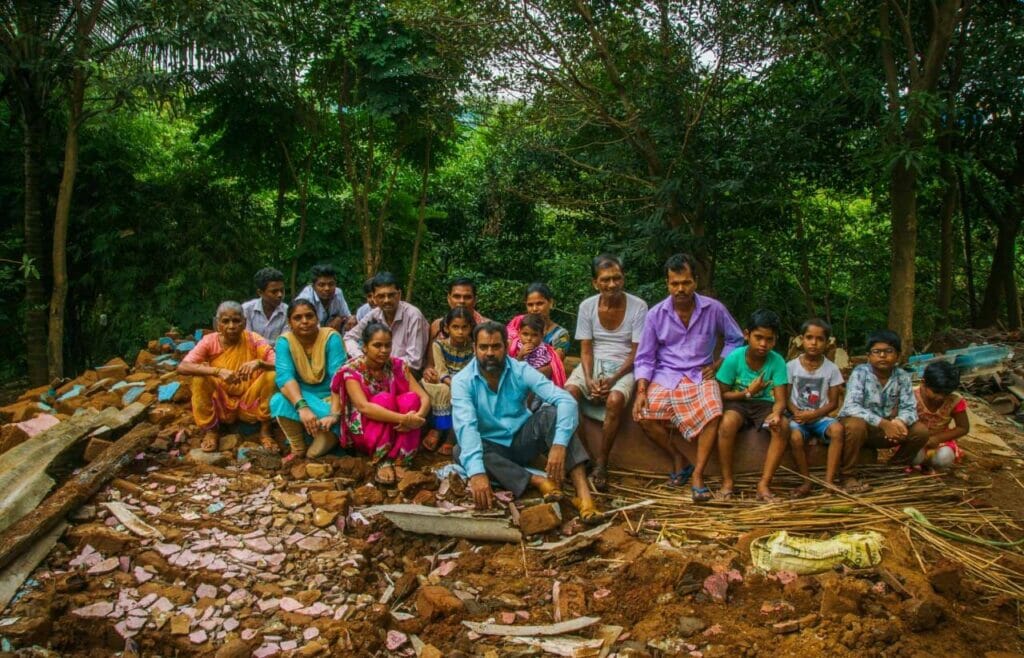On April 28, the villagers of Aarey Colony’s Prajapurpada village woke up to the piercing loud noise and the vibration of chainsaws as they witnessed hundreds of trees being cut down behind the barricades set up by the Mumbai Metro Rail Corporation Ltd. (MMRCL) for Metro-3 car shed. A huge police force, wood cutters and officials from the MMRCL began gathering at the project site around 5:30 am and felled more than 500 trees, claim locals and activists, even though they had permission to cut only 177.
They also alleged manipulation in the numbering of the trees that were the source of livelihood for many tribal and villagers living in the area for decades. Videos, which showed the hacking of trees with the sounds of the villagers weeping in the background, went viral after the incident.
Initially, the Supreme Court had specifically given permission to cut only 84 trees. However, the MMRCL sought permission from the Tree Authority of Mumbai to fell/transplant a total of 177 trees at Aarey Colony for Metro 3 car shed project. On April 17, the apex court, criticised the MMRCL and imposed a fine of Rs 10 lakh on it . The court, however, gave the permission to MMRCL to axe the 177 trees as the Bench noted that so far 2,000 trees had been felled and there was no point in forcing a public project to come to a “standstill”.
So, after receiving initial permission to cut 84 trees, there is a possibility of around 500 trees being actually axed, say activists.
MMRCL’s Contempt of Court
The bench comprising the Chief Justice of India DY Chandrachud, Justice PS Narasimha, and Justice JB Pardiwala criticised and said that the MMRCL has acted in contempt of the Court’s November 29 2022 order on the felling of trees at Aarey region. The court had given the MMRCL permission for 84 trees but on March 15 2023, they went ahead and took permission from the Superintendent of Gardens and Tree Officer of the Brihanmumbai Municipal Corporation (BMC), who granted them the permission for felling 124 trees and transplanting 53 trees.
This led to the a public interest litigation before the Bombay High Court which observed that the permission which was granted in respect of 177 trees was beyond the permission granted by the Supreme Court. It also noted that the trees shall not be felled until a clarification is sought from the apex court.
The Chief Justice expressing the bench’s annoyance towards the actions of the MMRCL said that they cannot take the court for a “ride”. He said, “How can you move for felling anymore trees in excess of 84 trees? If there was something in excess of 84, you should have come back to us. We would have granted permission subject to the hearing.”
In response, the Solicitor General of India appearing for the MMRCL apologised to the court and said that the permission for the 84 trees was required as per the 2019 survey but according to their latest survey they were required to cut more trees. “It is a lacuna but it was bonafide. The intention was not to overreach,” he said.
The court then granted the MMRCL permission for the 177 trees as they did not want the public project to discontinue. However, the court ordered the MMRCL to deposit Rs 10 lakh to the Conservator of Forests. He has to submit a report the status of compliance regarding afforestation and transplantation of trees. The court also ordered the Director of IIT Bombay to depute a team for the purpose of verifying and assisting the Conservator of Forests in the same regard.
Read more: “Aarey is the most abused and exploited land mass in Mumbai”
Felling and renumbering of more than 177 trees
Meanwhile environmentalists and locals alleged that 11 days after the verdict, on April 28, when the MMRCL cut down the trees in Aarey, they definitely cut more than 177 trees. “The number could be double or even triple as the numbering of the trees has been manipulated,” said environment activist, Sanjiv Valsan, who has been closely involved in the Save Aarey movement.
During the Supreme court hearing last month, Senior Advocate Gopal Sankaranarayanan had also mentioned that to expand the project’s area, the MMRCL had renumbered the trees which did not fall in the project, so that they could wrongfully cut them. “The map shows that the same number of trees have now come on the ramp and they want to cut it. The area has not changed. What has changed is their desire to cut more trees.”
The MMRCL did not respond to queries regarding the renumbering and the recent felling of more than 177 trees.

Source of livelihood axed with trees
More than 90% of the Adivasis who lived on that patch of land were forcibly evicted and pushed into Slum Rehabilitation Authority (SRA) buildings. The remaining 10% who stayed back for their land, witnessed all of their fruit bearing trees being hacked in the recent tree cutting. “These trees were the source of their livelihood but they were chopped down in front of them. This was also a way of pressuring them to leave the place,” said Stalin D, an environmental activist and director of NGO Vanashakti.
Many fruit bearing trees which the villagers grew and used for their source of income included fig trees, mango, coconut palm, papaya, banana, mulberry trees and more. Several of them were axed even without appropriate numbering.
The MMRCL had made a submission in 2019 that they won’t need to cut more trees but they have cut more than 700 trees within a year between 2022 to 2023, says Stalin. Moreover, there is no guarantee that they will not cut more trees, “They will go back in a year or two to the Supreme Court and say how urgently Mumbai needs the metro. Otherwise everything will collapse and so we need to cut trees, and the court will buy the absurd logic again and grant them more permissions. This will keep continuing,” added Stalin.

Metro line overrides other concerns
Activists claim that Aarey is the most eco-toxic metro line in the world which consists of flattening a hill, destroying flood plains and permanently affecting the entire ecosystem. The local tribal people have been relocated to SRA buildings, away from their homeland, where they are struggling to survive.
The construction of the metro line has been overriding everything else including the environment, the homeless people and the several attempts to stop the felling of trees.
According to Sanjiv, three cases have been filed by the activists to stop the felling of trees but they haven’t received a date for the hearing. “But the MMRCL conveniently gets a court date and also the required permission to chop trees. So by the time we get a hearing, there will be nothing much to save.”